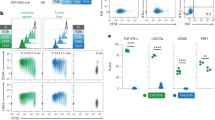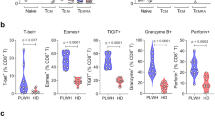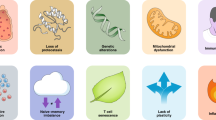Abstract
Recent thymic emigrants can be identified by T cell receptor excision circles (TRECs) formed during T-cell receptor rearrangement. Decreasing numbers of TRECs have been observed with aging and in human immunodeficiency virus (HIV)-1 infected individuals, suggesting thymic impairment. Here, we show that in healthy individuals, declining thymic output will affect the TREC content only when accompanied by naive T-cell division. The rapid decline in TRECs observed during HIV-1 infection and the increase following HAART are better explained not by thymic impairment, but by changes in peripheral T-cell division rates. Our data indicate that TREC content in healthy individuals is only indirectly related to thymic output, and in HIV-1 infection is mainly affected by immune activation.
This is a preview of subscription content, access via your institution
Access options
Subscribe to this journal
Receive 12 print issues and online access
$209.00 per year
only $17.42 per issue
Buy this article
- Purchase on Springer Link
- Instant access to full article PDF
Prices may be subject to local taxes which are calculated during checkout





Similar content being viewed by others
References
Gaulton, G.N., Scobie, J.V. & Rosenzweig, M. HIV-1 and the thymus. AIDS. 11, 403–414 (1997).
Hazenberg, M.D., Clark, D.R. & Miedema, F. Tilted balance of T cell renewal in HIV-1 infection. AIDS Rev. 1, 67–73 (1999).
Douek, D.C. et al. Changes in thymic function with age and during the treatment of HIV infection. Nature 396, 690–695 (1999).
Livak, F. & Schatz, D.G. T-cell receptor alpha locus V(D)J recombination by-products are abundant in thymocytes and mature T cells. Mol. Cell. Biol. 16, 609–618 (1998).
De Villartay, J.P., Hockett, R.D., Coran, D., Korsmeyer, S.J. & Cohen, D.I. Deletion of the human T-cell receptor δ-gene by a site specific recombination. Nature 335, 170–174 (1988).
Breit, T.M. et al. Rearrangements of the human TCRD-deleting elements. Immunogenetics 40, 70–75 (1994).
Verschuren, M.C.M. et al. Preferential rearrangements of the T cell receptor—-deleting elements in human T cells. J. Immunol. 158, 1208–1216 (1997).
Breit, T.M., Verschuren, M.C.M., Wolvers-Tettero, I.L.M, Van Gastel-Mol, E.J. & Van Dongen, J.J.M. Human T cell leukemias with continuous V(D)J recombinase activity for TCR-δ gene deletion. J. Immunol. 159, 4341–4349 (1997).
Nakajima, P.B., Menetski, J.P., Roth, D.B., Gellert, M. & Bosma, M.J. V-D-J- Rearrangements at the T cell receptor δ locus in mouse thymocytes of the αβ lineage. Immunity 3, 609–621 (1995).
Zhang, L. et al. Measuring recent thymic emigrants in blood of normal and HIV-1-infected individuals before and after effective therapy. J. Exp. Med. 190, 725–732 (1999).
Jamieson, B.D. et al. Generation of functional thymocytes in the human adult. Immunity 10, 569–575 (1999).
Poulin, J.-F. et al. Direct evidence for thymic function in adult humans. J. Exp. Med. 190, 479–486 (1999).
Hatzakis, A. et al. Effect of recent thymic emigrants on progression of HIV-1 disease. Lancet 355, 599–604 (2000).
Hazenberg, M.D. et al. T cell division in human immunodeficiency virus (HIV-1)-infection is mainly due to immune activation: a longitudinal analysis in patients before and during highly active anti-retroviral therapy. Blood 95, 249–255 (2000).
Meyaard, L., Otto, S.A., Keet, I.P.M., Roos, M.Th.L. & Miedema, F. Programmed death of T cells in HIV-1 infection: no correlation with progression to disease. J. Clin. Invest. 93, 982–988 (1994).
Grossman, Z., Herberman, R.B. & Dimitrov, D.S. T cell turnover in SIV infection. Science 284, 555a–1999).
Gerdes, J. et al. Cell cycle analysis of a cell proliferation-associated human nuclear antigen defined by the monoclonal antibody Ki-67. J. Immunol. 133, 1710–1715 (1984).
Kong, F.-K. Chen, C.-L.H., Six, A., Hockett, R.D. & Cooper, M.D. T cell receptor gene deletion circles identify recent thymic emigrants in the peripheral T cell pool. Proc. Natl. Acad. Sci. USA 96, 1536–1540 (1999).
Sprent, J. Lifespan of naive, memory and effector lymphocytes. Curr. Op. Immunol. 5, 433–438 (1993).
Mclean, A.R. & Michie, C.A. In vivo estimates of division and death rates of human T lymphocytes. Proc. Natl. Acad. Sci. USA 92, 3707–3711 (1995).
Walker, R.E. et al. Peripheral expansion of pre-existing mature T cells is an important means of CD4+ T-cell regeneration in HIV-infected adults. Nature Med. 4, 852–856 (1998).
Messele, T. et al. Reduced naive and increased activated CD4 and CD8 cells in healthy adult Ethiopians compared with their Dutch counterparts. J. Clin. Exp. Immunol. 115, 443–450 (1999).
Sachsenberg, N. et al. Turnover of CD4+ and CD8+ T lymphocytes in HIV-1 infection as measured by Ki-67 antigen. J. Exp. Med. 187, 1295–1303 (1998).
Roos, M.Th.L. et al. Viro-immunological studies in acute HIV-1 infection. AIDS 8, 1533–1538 (1994).
Roos, M.Th.L. et al. Viral phenotype and immune response in primary human immunodeficiency virus type 1 (HIV-1) infection. J. Infect. Dis. 165, 427–432 (1992).
HIntzen, R.Q. et al. Regulation of CD27 expression on subsets of mature T lymphocytes. J. Immunol. 151, 2426–2435 (1993).
Tough, D.F. & Sprent, J. Turnover of naive- and memory-phenotype T cells. J. Exp. Med. 179, 1127–1135 (1994).
Unutmaz, D., Baldoni, F. & Abrignani, S. Human naive T cells activated by cytokines differentiate into a split phenotype with functional features intermediate between naive and memory cells. Int. Immunol. 7, 1417–1424 (1995).
Unutmaz, D., Pileri, P. & Abrignani, S. Antigen-independent activation of naive and memory resting T cells by a cytokine combination. J. Exp. Med. 180, 1159–1164 (1994).
Wolthers, K.C. et al. T-cell telomere length in HIV-1 infection: no evidence for increased CD4+ T cell turnover. Science 274, 1543–1547 (1996).
Wolthers, K.C., Noest, A.J., Otto, S.A., Miedema, F. & DeBoer, R.J. Normal telomere lengths in naive and memory CD4+ T cells in HIV-1 infection: a mathematical interpretation. AIDS Res. Hum. Retroviruses. 15, 1053–1062 (1999).
Clark, D.R., De Boer, R.J., Wolthers, K.C. & Miedema, F. T cell dynamics in HIV-1 infection. Adv. Immunol. 73, 301–327 (1999).
Pakker, N.G. et al. Biphasic kinetics of peripheral blood T cells after triple combination therapy in HIV-1 infection: a composite of redistribution and proliferation. Nature Med. 4, 208–214 (1998).
Hellerstein, M.K. & McCune, J.M. T cell turnover in HIV-1 disease. Immunity. 7, 583–589 (1997).
George, A.J.T. & Ritter, M.A. Thymic involution with aging: obsolescence or good housekeeping? Immunol. Today 17, 267–272 (1996).
Boom van Noorloos, A.A., Van Beek, A.A.M. & Melief, C.J.M. Cryopreservation of cells for immunological typing of non-Hodgkin's lymphomas. Cancer Res. 40, 2890–2894 (1980).
Hamann, D. et al. Phenotypic and functional separation of memory and effector human CD8+ T cells. J. Exp. Med. 186, 1407–1418 (1997).
Baars, P.A., Maurice, M.M., Rep, M., Hooibrink, B. & Van Lier, R.A.W. Heterogeneity of the circulating human CD4+ T-cell population: Further evidence that the CD4+CD45RA−CD27− T-cell subset contains specialized primed cells. J. Immunol. 154, 17–25 (1995).
Hellerstein, M. et al. Directly measured kinetics of circulating T lymphocytes in normal and HIV-1 infected humans. Nature Med. 5, 83–89 (1999).
Pongers-Willemse, M.J. et al. Real-time quantitative PCR for the detection of minimal residual disease in acute lymphoblastic leukemia using junctional region specific TaqMan probes. Leukemia 12, 2006–2014 (1998).
Acknowledgements
Patients and physicians are gratefully acknowledged for their participation in the studies. We thank Marja J. Willemse and Bas Dutilh for technical assistance, and Hanneke Schuitemaker and Rene van Lier for critical reading of the manuscript. This study was financially supported by the Dutch AIDS Foundation, the Netherlands Ministry of Foreign Affairs and the Ethiopian Ministry of Health (EHNRI-ENARP), Hoffman-La Roche, Bristol Myers Squibb and Dutch Cancer Society / Koningin Wilhelmina Fonds (grant EUR 95-1015; M.V. and J.vD.).
Author information
Authors and Affiliations
Corresponding author
Rights and permissions
About this article
Cite this article
Hazenberg, M., Otto, S., Stuart, J. et al. Increased cell division but not thymic dysfunction rapidly affects the T-cell receptor excision circle content of the naive T cell population in HIV-1 infection. Nat Med 6, 1036–1042 (2000). https://doi.org/10.1038/79549
Received:
Accepted:
Issue Date:
DOI: https://doi.org/10.1038/79549
This article is cited by
-
Role of thymosin α1 in restoring immune response in immunological nonresponders living with HIV
BMC Infectious Diseases (2024)
-
Can T-cell and B-cell excision circles predict development of inhibitors in pediatric hemophilia A?
Pediatric Research (2023)
-
The effect of age on CD4+ T-cell recovery in HIV-suppressed adult participants: a sub-study from AIDS Clinical Trial Group (ACTG) A5321 and the Bone Loss and Immune Reconstitution (BLIR) study
Immunity & Ageing (2022)
-
T-cell Receptor Excision Circles in Newborns with Heart Defects
Pediatric Cardiology (2020)
-
Lymphocyte homeostasis is maintained in perinatally HIV-infected patients after three decades of life
Immunity & Ageing (2019)



